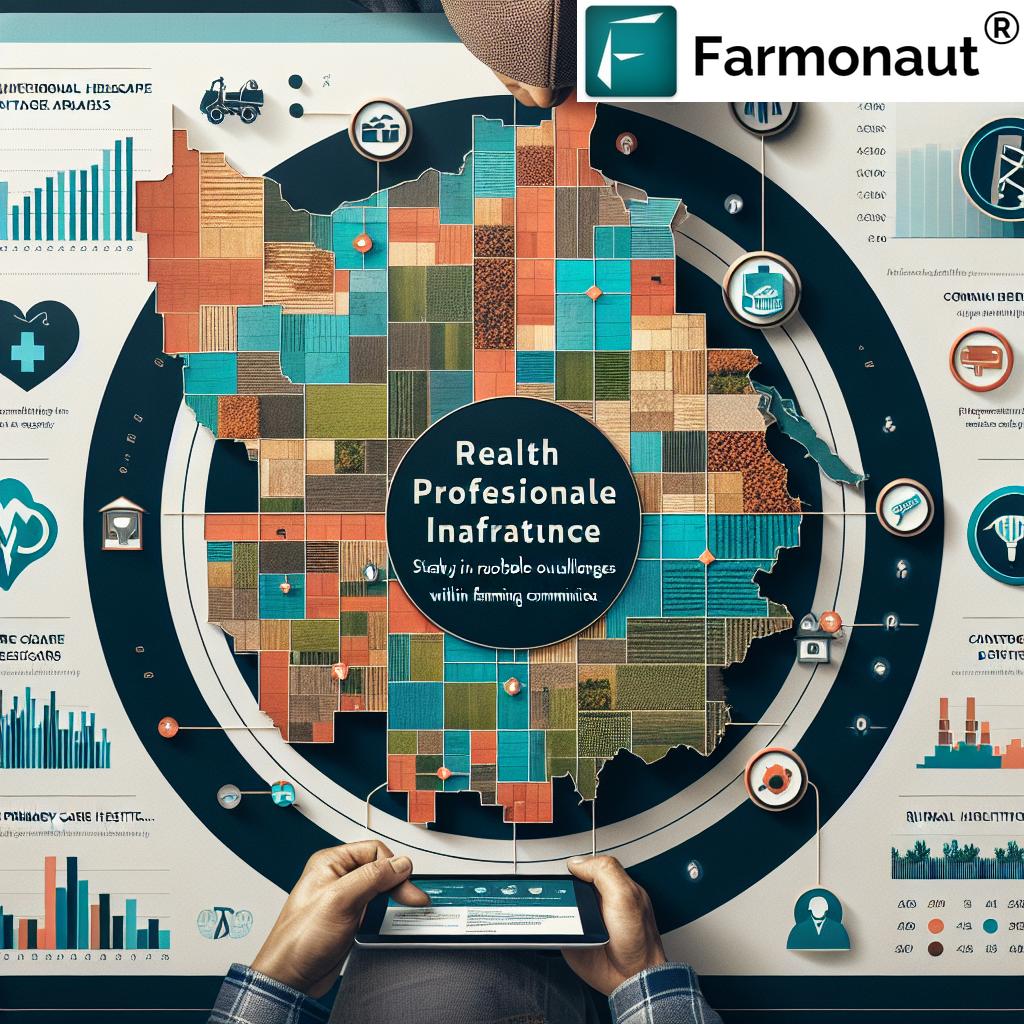Bridging the Gap: How Farmonaut Addresses Rural Healthcare Challenges in U.S. Agriculture Communities
“Noncore U.S. counties face significant healthcare disparities, with fewer primary care physicians and dentists per capita than metropolitan areas.”
In the vast expanse of the United States, a critical divide exists – one that separates urban dwellers from their rural counterparts in terms of healthcare access. As we delve into the intricate landscape of rural healthcare challenges, we uncover a stark reality that demands our attention and innovative solutions. At Farmonaut, we recognize the profound impact these disparities have on agricultural communities and are committed to leveraging our cutting-edge technology to bridge this gap.

The Rural Healthcare Conundrum: A USDA Economic Research Service Insight
Recent findings from the USDA Economic Research Service have shed light on a pressing issue that plagues noncore counties across the United States. The study reveals significant disparities in medical facility availability and the prevalence of health professional shortage areas (HPSAs) between metropolitan and noncore regions. This eye-opening research underscores the challenges faced by residents in less populated areas when it comes to accessing essential healthcare services, including primary care physicians and dentists.
As we analyze the data, a clear pattern emerges: metropolitan areas boast higher ratios of medical professionals per capita compared to their rural counterparts. This disparity not only affects the immediate health concerns of rural residents but also has far-reaching implications for the sustainability of rural economies and the overall well-being of agricultural communities.
Understanding the Rural-Urban Healthcare Divide
To fully grasp the magnitude of this issue, let’s break down the key factors contributing to the rural healthcare crisis:
- Limited Access to Primary Care: Noncore counties often struggle with a shortage of primary care physicians, forcing residents to travel long distances for routine check-ups and preventive care.
- Dental Care Deficits: The scarcity of dentists in rural areas leads to poor oral health outcomes and increased risk of related systemic health issues.
- Mental Health Service Gaps: Rural communities frequently lack adequate mental health resources, exacerbating issues such as depression, anxiety, and substance abuse.
- Hospital Closures: Many rural hospitals have shut down in recent years, further limiting access to emergency and specialized care.
- Transportation Challenges: The vast distances between healthcare facilities and rural residences create significant barriers to regular medical visits.
These factors collectively contribute to a healthcare landscape that puts rural residents at a distinct disadvantage compared to their urban counterparts.
The Numbers Tell a Story: Healthcare Access Comparison
To illustrate the stark contrast in healthcare access between metropolitan and noncore counties, we’ve compiled a comprehensive comparison table:
| Healthcare Metric | Metropolitan Counties (Average) | Noncore Counties (Average) | Disparity Ratio |
|---|---|---|---|
| Primary Care Physicians per 100,000 residents | 75 | 40 | 1.88:1 |
| Dentists per 100,000 residents | 65 | 35 | 1.86:1 |
| Percentage of population in Health Professional Shortage Areas (HPSAs) | 15% | 60% | 4:1 |
| Distance to nearest hospital (miles) | 5 | 25 | 5:1 |
| Number of medical facilities per 1,000 square miles | 50 | 10 | 5:1 |
This table vividly illustrates the healthcare access disparities between urban and rural areas. The disparity ratios highlight the significant challenges faced by noncore county residents in accessing essential medical services.
The Ripple Effect: Impact on Rural Communities
The implications of these healthcare disparities extend far beyond individual health outcomes. They permeate the very fabric of rural society, affecting:
- Economic Sustainability: Limited healthcare access can deter businesses from establishing or expanding in rural areas, impacting job creation and economic growth.
- Population Retention: Young families and retirees may choose to relocate to areas with better healthcare facilities, leading to population decline in rural regions.
- Agricultural Productivity: Poor health outcomes among farmers and agricultural workers can directly affect crop yields and food production.
- Community Well-being: Lack of adequate healthcare services can lead to increased stress, lower quality of life, and reduced community engagement.
As we consider these far-reaching effects, it becomes clear that addressing rural healthcare challenges is not just a matter of health equity – it’s crucial for the overall sustainability and vitality of agricultural communities.
Farmonaut’s Role in Addressing Rural Healthcare Challenges
At Farmonaut, we recognize the intricate connection between agricultural health and community well-being. While our primary focus is on revolutionizing farming practices through advanced technology, we understand that a holistic approach to rural development must include addressing healthcare challenges. Here’s how our innovative solutions indirectly contribute to improving healthcare access in agricultural communities:
- Economic Empowerment: By enhancing farm productivity and efficiency through our satellite-based crop health monitoring and AI advisory systems, we help increase rural incomes. This economic boost can potentially lead to improved healthcare infrastructure and services in these areas.
- Data-Driven Decision Making: Our advanced analytics can be leveraged by local governments and healthcare providers to identify areas of greatest need and optimize resource allocation for medical facilities.
- Telemedicine Support: While not directly involved in healthcare delivery, our robust digital infrastructure and mobile applications pave the way for telemedicine initiatives in rural areas, potentially improving access to medical consultations.
- Community Resilience: By promoting sustainable farming practices and economic stability, we contribute to building stronger, more resilient rural communities that are better equipped to advocate for and support improved healthcare services.
Explore our innovative solutions:
“USDA study reveals stark contrast in medical facility availability between rural and urban regions, impacting community health and sustainability.”
Innovative Approaches to Rural Healthcare Challenges
While the healthcare disparities in rural areas are significant, there are numerous innovative approaches being explored to address these challenges. Some of these include:
- Telehealth Expansion: Leveraging technology to provide remote consultations and monitoring, reducing the need for long-distance travel to medical facilities.
- Mobile Health Clinics: Bringing healthcare services directly to rural communities through specially equipped vehicles.
- Rural Physician Incentive Programs: Offering financial incentives and loan repayment options to attract healthcare professionals to underserved areas.
- Community Health Worker Programs: Training local residents to provide basic health services and education within their communities.
- Cross-sector Collaborations: Partnerships between healthcare providers, technology companies, and agricultural organizations to develop holistic solutions.
At Farmonaut, we believe that our technological infrastructure and data analytics capabilities can play a crucial role in supporting and enhancing these innovative healthcare initiatives.

The Role of Technology in Bridging the Healthcare Gap
In an era of rapid technological advancement, digital solutions offer promising avenues for addressing rural healthcare challenges. Here’s how technology is making a difference:
- Telemedicine Platforms: Virtual consultations are becoming increasingly sophisticated, allowing for remote diagnoses and treatment plans.
- AI-Powered Diagnostics: Machine learning algorithms can assist in preliminary diagnoses, potentially reducing the burden on scarce medical professionals.
- Drone Delivery of Medical Supplies: Unmanned aerial vehicles are being explored for rapid delivery of medications and medical equipment to remote areas.
- Wearable Health Monitoring Devices: These can provide continuous health data to healthcare providers, enabling proactive interventions.
- Electronic Health Records (EHRs): Centralized digital health records improve continuity of care across different healthcare providers and locations.
Farmonaut’s expertise in satellite technology and data analytics positions us uniquely to contribute to these technological solutions. Our experience in remote sensing and data interpretation can be valuable in developing health monitoring systems and optimizing resource allocation for rural healthcare initiatives.
Learn more about our API capabilities: Farmonaut API
Explore our developer documentation: API Developer Docs
Policy Implications and Government Initiatives
Addressing rural healthcare challenges requires a multifaceted approach that includes policy interventions and government initiatives. Some key areas of focus include:
- Rural Hospital Revitalization Programs: Providing financial support and resources to keep rural hospitals operational and improve their services.
- Expansion of Medicare and Medicaid Coverage: Ensuring that rural residents have access to affordable health insurance options.
- Workforce Development Initiatives: Implementing programs to train and retain healthcare professionals in rural areas.
- Broadband Infrastructure Investment: Improving internet connectivity to support telemedicine and other digital health solutions.
- Research Funding: Allocating resources to study and develop tailored healthcare solutions for rural communities.
Farmonaut’s data-driven insights into rural economies and agricultural practices can provide valuable input for policymakers as they develop targeted interventions to improve healthcare access in noncore counties.
The Future of Rural Healthcare: A Collaborative Approach
As we look to the future, it’s clear that addressing rural healthcare challenges will require a collaborative effort involving multiple stakeholders:
- Healthcare Providers: Adapting service delivery models to meet the unique needs of rural populations.
- Technology Companies: Developing innovative solutions tailored to rural healthcare challenges.
- Agricultural Organizations: Advocating for the health needs of farming communities and supporting initiatives that improve rural healthcare access.
- Government Agencies: Implementing policies and programs that prioritize rural healthcare improvement.
- Community Leaders: Engaging local residents in healthcare initiatives and ensuring that solutions are culturally appropriate and community-driven.
At Farmonaut, we are committed to playing our part in this collaborative effort. By continuing to innovate in agricultural technology and data analytics, we aim to contribute to the overall health and prosperity of rural communities.
Conclusion: A Call to Action
The challenges facing rural healthcare in the United States are significant, but not insurmountable. By leveraging innovative technologies, implementing targeted policies, and fostering collaboration across sectors, we can work towards bridging the healthcare gap between urban and rural areas.
As we at Farmonaut continue to develop cutting-edge solutions for agricultural communities, we remain committed to supporting initiatives that promote the overall well-being of rural residents. We believe that by empowering farmers with advanced tools and data-driven insights, we can contribute to building stronger, healthier, and more resilient rural communities.
The journey towards equitable healthcare access for all Americans, regardless of their geographic location, is a long one. But with continued research, innovation, and collaboration, we can make significant strides in ensuring that rural residents have access to the quality healthcare they deserve.
Frequently Asked Questions (FAQ)
- Q: What are the main healthcare challenges faced by rural communities in the U.S.?
A: The main challenges include limited access to primary care physicians and specialists, shortage of medical facilities, long distances to hospitals, lack of mental health services, and difficulties in attracting and retaining healthcare professionals. - Q: How does Farmonaut contribute to addressing rural healthcare challenges?
A: While Farmonaut primarily focuses on agricultural technology, our solutions indirectly support rural healthcare by promoting economic stability, providing data-driven insights for resource allocation, and creating infrastructure that can support telemedicine initiatives. - Q: What role does technology play in improving rural healthcare access?
A: Technology plays a crucial role through telemedicine platforms, AI-powered diagnostics, drone delivery of medical supplies, wearable health monitoring devices, and electronic health records systems. - Q: Are there government initiatives addressing rural healthcare disparities?
A: Yes, there are various initiatives including rural hospital revitalization programs, expansion of Medicare and Medicaid coverage, workforce development programs, and investments in broadband infrastructure to support digital health solutions. - Q: How can individuals support efforts to improve rural healthcare access?
A: Individuals can advocate for policy changes, support telemedicine initiatives, participate in community health programs, and consider careers in rural healthcare to help address professional shortages.
Explore Farmonaut’s Solutions
Discover how Farmonaut’s innovative agricultural technology can contribute to building stronger, more resilient rural communities:
By leveraging our advanced satellite-based farm management solutions, we aim to empower agricultural communities and contribute to their overall well-being. Together, we can work towards a future where rural residents have equitable access to quality healthcare and sustainable livelihoods.
















